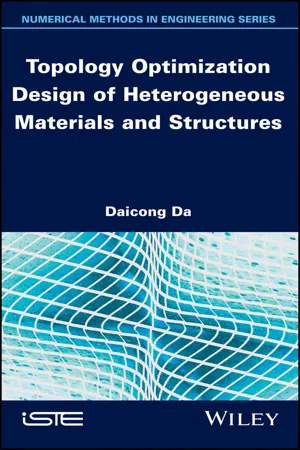
- English
- ePUB (mobile friendly)
- Available on iOS & Android
Topology Optimization Design of Heterogeneous Materials and Structures
About this book
This book pursues optimal design from the perspective of mechanical properties and resistance to failure caused by cracks and fatigue. The book abandons the scale separation hypothesis and takes up phase-field modeling, which is at the cutting edge of research and is of high industrial and practical relevance. Part 1 starts by testing the limits of the homogenization-based approach when the size of the representative volume element is non-negligible compared to the structure. The book then introduces a non-local homogenization scheme to take into account the strain gradient effects. Using a phase field method, Part 2 offers three significant contributions concerning optimal placement of the inclusion phases. Respectively, these contributions take into account fractures in quasi-brittle materials, interface cracks and periodic composites. The topology optimization proposed has significantly increased the fracture resistance of the composites studied.
Frequently asked questions
- Essential is ideal for learners and professionals who enjoy exploring a wide range of subjects. Access the Essential Library with 800,000+ trusted titles and best-sellers across business, personal growth, and the humanities. Includes unlimited reading time and Standard Read Aloud voice.
- Complete: Perfect for advanced learners and researchers needing full, unrestricted access. Unlock 1.4M+ books across hundreds of subjects, including academic and specialized titles. The Complete Plan also includes advanced features like Premium Read Aloud and Research Assistant.
Please note we cannot support devices running on iOS 13 and Android 7 or earlier. Learn more about using the app.
Information
PART 1
Multiscale Topology Optimization in the Context of Non-separated Scales
1
Size Effect Analysis in Topology Optimization for Periodic Structures Using the Classical Homogenization
1.1. The classical homogenization method
1.1.1. Localization problem
Table of contents
- Cover
- Table of Contents
- Introduction
- PART 1: Multiscale Topology Optimization in the Context of Non-separated Scales
- PART 2: Topology Optimization for Maximizing the Fracture Resistance
- Conclusion
- References
- Index
- End User License Agreement